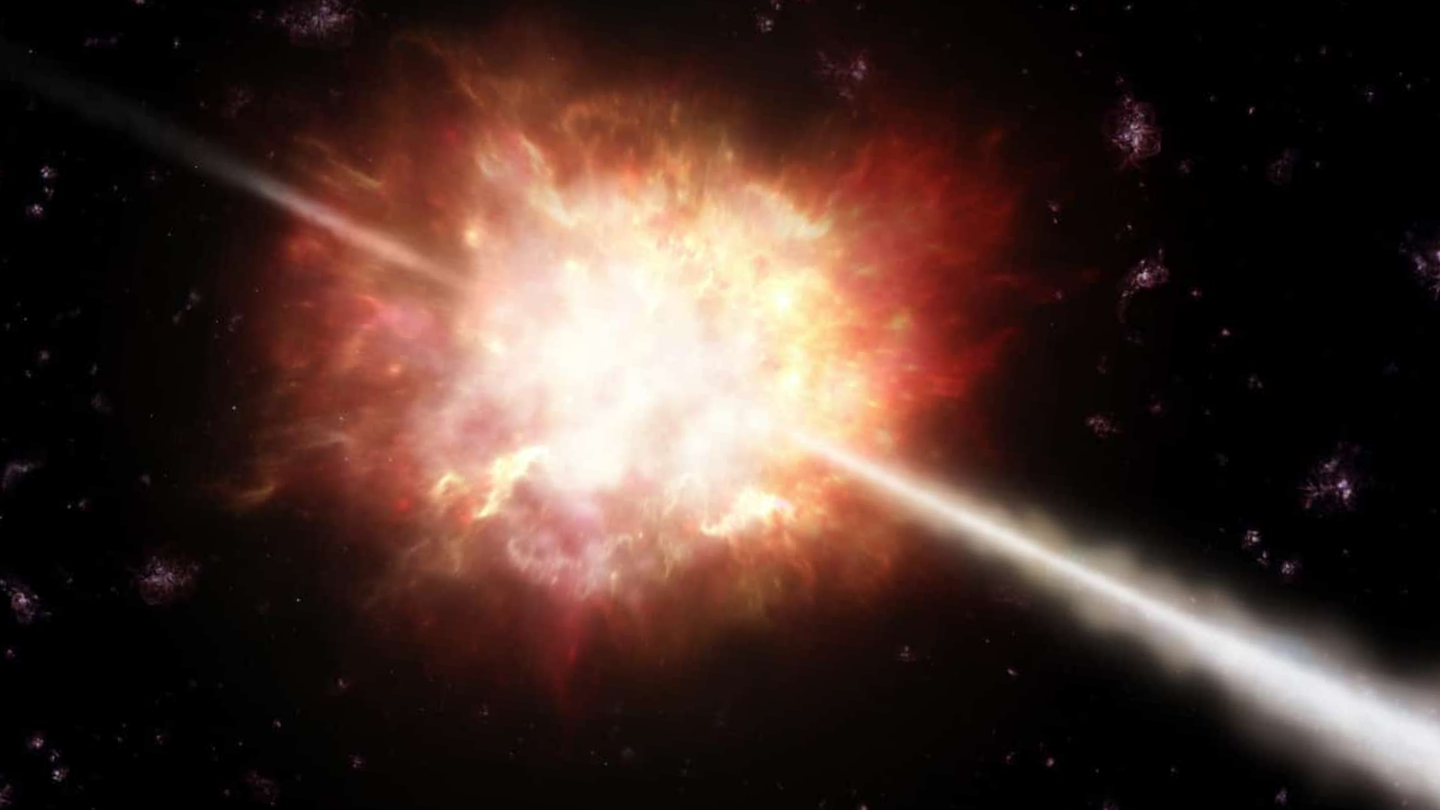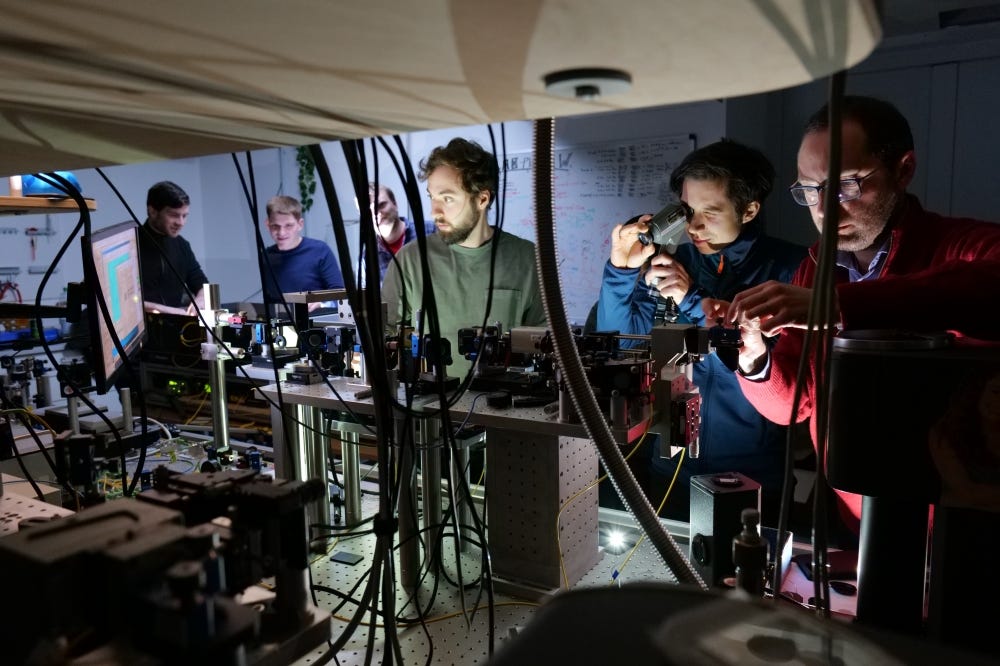Rare black hole-star merger creates the longest gamma-ray burst ever
Astronomers have the strongest evidence yet that ultra-long gamma-ray bursts can form when a black hole merges with a massive star’s core.

The cosmic flash, known as GRB 250702B, wasn’t just another gamma-ray burst—it was the longest-lasting one ever recorded, blazing for nearly seven hours. (CREDIT: ESO/A. Roquette)
When space telescopes blazed with high-energy radiation for hours earlier this year, astronomers suspected that they were witnessing something special. The cosmic flash GRB 250702B was no run-of-the-mill gamma-ray burst—it was the longest-lasting one ever recorded, burning for nearly seven hours.
Gamma-ray bursts, or GRBs, are the universe's most cataclysmic eruptions, typically waning within minutes or seconds. But GRB 250702B persisted longer than all the others before it, dwarfing the previous record holder, GRB 111209A, by nearly three hours. The dazzling display pushed scientists to rewrite the textbooks on how such cosmic fireworks begin.
A Burst Unlike Any Other
The event first appeared on July 2, 2025, when the NASA Fermi Gamma-ray Burst Monitor saw unusual signs that persisted for more than three hours. Records later arrived from other observatories—the Konus-Wind detector, Japan's Einstein Probe, and the Psyche-GRNS instrument—showed that the same source was behind the extended emission.
By combining InterPlanetary Network signals, researchers reconstructed the complete profile of the event. The research recorded a duration of approximately 25,000 seconds, or about seven hours. "We see a hard spectrum, subsecond variability, and high total energy, which are only known to come from ultrarelativistic jets powered by a millisecond-stable stellar-mass central engine," the authors of the study stated in their study report.
More simply stated, this was not the kind of explosion one might anticipate when one giant star forms a black hole, a "collapsar," as is generally so with long GRBs. The evidence resisted that model or any other hypothesis they could think of.
Finding the Source
To describe GRB 250702B, an international group of more than 50 astrophysicists explored nearly every possibility in the playbook. Was it a magnetar flare, a neutron-star merger, or a supermassive black hole at the center of a galaxy? Each successively eliminated.
The energy outputs were too high to be a magnetar or a binary merger. The timescale was much larger than collapsars can provide before their stars spin down. And the location of the event, off the nucleus of its host galaxy, ruled out an active galactic nucleus.
That left standing was a violent and unusual cosmic dance known as a helium-merger event—a black hole plunging into the helium core of a companion star.
The Helium Merger Model
Two massive stars are matched in this model and orbit around one another until one collapses into a black hole. The other star expands in its later phase, and the black hole gravitates towards the center, trapped inside the expanding stellar envelope. The friction tightens the orbit until the black hole penetrates the star's helium core.
By this stage, a powerful accretion disk forms around the black hole, propelling material inwards and ejecting twin jets at near the speed of light. Those jets last tens of thousands of seconds and produce the gamma rays seen on Earth.
"The angular momentum taken out of the orbit is transferred to the helium star, and as the black hole is making its way to the center of the core, the high angular momentum will propel the helium core to accrete through a disk," the authors explained. Magnetic fields and turbulence in the disk build enormous energy, igniting an explosion that can look like—and even last longer than—a supernova.
Testing the Theory
Simulations of black holes with masses of about two solar masses and 32- to 60-solar-mass helium stars duplicated the light curves of GRB 250702B observed. The Blandford–Znajek process, a mechanism for extracting energy from a spinning black hole, mimicked the steady rise and gradual decline in intensity in the burst.
Even the smallest details—like shifts in photon energy and sub-second flickering—aligned with what the team observed through Fermi’s NaI and BGO detectors. These findings, together with extended detections by MAXI and Psyche-GRNS, confirmed that the long-lived emission came from one continuous event rather than unrelated flashes.
The Supernova That Wasn’t
After the initial fireworks, astronomers went back to the James Webb Space Telescope for a second glance. They were expecting to discover an incandescent supernova at the burst's site about 25 days later. Instead, nothing—no afterglow and no characteristic transient light.
That lack might in fact strengthen the case for helium-merger. Simulations suggest that after a black hole reaches five solar masses, the conditions in the accretion disk prevent the creation of nickel-56, the radioactive isotope that illuminates supernovae. Any follow-up explosion would have been too weak to be overwhelmed by the host galaxy's dusty light.
The Team Behind the Discovery
The project's success came from international cooperation. Eliza Neights was in charge of the background fitting and spectral analysis of the Fermi GBM data in general. Eric Burns coordinated the collaboration and evaluated the energy budget of the event. Chris Fryer performed helium-merger physics simulations, and Dmitry Svinkin worked on Konus-Wind data to compare GRB 250702B with earlier gamma-ray bursts.
Their study was supported by NASA, the United States–Israel Binational Science Foundation, and international collaborators who supplied pre-publication data for an accelerated review of the results.
A New Window Into the Cosmos
The detection of GRB 250702B brings forth a new window of high-energy astronomy. It provides the most robust indication to date that some ultra-long gamma-ray bursts result from mergers of black holes with massive stars, not from the collapse of individual stars.
This realization reshapes the way scientists view stellar death, jet formation, and even gravitational-wave sources. The merger of a black hole with a star can potentially connect two previously independent phenomena—gamma-ray bursts and the spacetime ripples observatories like LIGO and Virgo have detected.
Future missions, including the Legacy Survey of Space and Time by the Vera Rubin Observatory and the future Compton Spectrometer and Imager, will raise the stakes for the detection of these kinds of exotic cosmic fireworks. With better coverage and longer views, scientists expect to observe more of these ultra-long GRBs and gain the entire life histories of the stars that fuel them.
Practical Implications of the Research
Decoding GRB 250702B not only breaks a record—it enlightens us on how black holes form and binary star systems evolve.
Such discoveries could refine models of supernovae explosions and increase predictions of gravitational-wave signals, allowing scientists to identify the origins of gargantuan cosmic crashes.
By linking GRBs with black-hole mergers, scientists move researchers closer to mapping how elements, radiation, and even components of life are spread throughout the universe.
Research findings are available online in the journal arXiv.
Related Stories
- Astronomers capture first-ever image of two black holes orbiting each other
- Black hole stars: Giant stars may hide black holes at their core
- A wormhole from another universe? Scientists revisit the puzzling black hole GW190521
Like these kind of feel good stories? Get The Brighter Side of News' newsletter.
Joshua Shavit
Science & Technology Writer and Editor
Joshua Shavit is a Los Angeles-based science and technology writer with a passion for exploring the breakthroughs shaping the future. As a co-founder of The Brighter Side of News, he focuses on positive and transformative advancements in AI, technology, physics, engineering, robotics and space science. Joshua is currently working towards a Bachelor of Science in Business and Industrial Engineering at the University of California, Berkeley. He combines his academic background with a talent for storytelling, making complex scientific discoveries engaging and accessible. His work highlights the innovators behind the ideas, bringing readers closer to the people driving progress.



